The growing post-war enrolment at UBC forced the government to look for means by which to address the growing financial requirements of the institution. Given that the original land endowment had provided no support and students were not charged fees, the University relied solely for its operating grant on government funds.
In 1920, the two million acres originally granted as an endowment in 1907 were surrendered to the Crown in return for "3,000 acres more or less" of land owned by the province in the westerly part of Point Grey. Given the proximity to Vancouver, it was anticipated that the proceeds of land sales and leases would provide a relatively secure form of revenue for the University. Unfortunately, for various reasons, this land endowment also failed to produce the desired results.
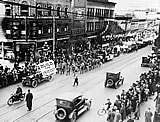 It
would seem that, despite the expanding student body jamming into the increasingly
inadequate facilities at Fairview, the government had little interest in financing
a new Point Grey campus. Presidents Wesbrook and then Klinck laboured for almost ten
years to convince the provincial government to provide the funds for a proper campus.
It was, however, the student publicity campaign of 1922 culminating in the Great Trek
that helped galvanize and articulate public support that convinced the government
to resume construction at Point Grey.
It
would seem that, despite the expanding student body jamming into the increasingly
inadequate facilities at Fairview, the government had little interest in financing
a new Point Grey campus. Presidents Wesbrook and then Klinck laboured for almost ten
years to convince the provincial government to provide the funds for a proper campus.
It was, however, the student publicity campaign of 1922 culminating in the Great Trek
that helped galvanize and articulate public support that convinced the government
to resume construction at Point Grey.
The government agreed to complete the Science Building, Library and Power House according to the original Sharp and Thompson plans. The remaining building needs would be met through the construction of "semi-permanent" buildings designed by Public Works to help reduce costs. These buildings were to be placed in an area designated as an "unassigned" quadrangle in the original campus plan so as to leave space for the construction of proper buildings in the future. The semi-permanent buildings were to include: Arts and Science, Agriculture, Applied Science, Engineering, Administration, Auditorium (and cafeteria) and Gymnasium.
 Unfortunately
cost considerations forced the cancellation of the Gymnasium. Construction
began on the other semi-permanent buildings in the spring of 1924. These
wood-frame buildings with stucco finish were projected to last between
25 and 40 years if necessary. Despite their impermanence these buildings
are still in use some 76 years later, albeit some now with different
tenants.
Unfortunately
cost considerations forced the cancellation of the Gymnasium. Construction
began on the other semi-permanent buildings in the spring of 1924. These
wood-frame buildings with stucco finish were projected to last between
25 and 40 years if necessary. Despite their impermanence these buildings
are still in use some 76 years later, albeit some now with different
tenants.
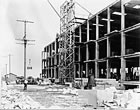
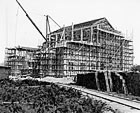 The
relatively remote location of the Point Grey campus and the lack of
adequate roads to service the site presented some interesting challenges
for this massive construction project. One proposed solution included
asking the B.C. Electric Railway to build a branch line to Point Grey.
The
relatively remote location of the Point Grey campus and the lack of
adequate roads to service the site presented some interesting challenges
for this massive construction project. One proposed solution included
asking the B.C. Electric Railway to build a branch line to Point Grey.
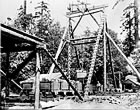 In
the end, it was decided to construct an aerial tramway to lift building
material from a wharf at the foot of the Point Grey cliffs to the top
where they would be transferred to a small railway train that carried
them to the Library and Science Building construction sites.
In
the end, it was decided to construct an aerial tramway to lift building
material from a wharf at the foot of the Point Grey cliffs to the top
where they would be transferred to a small railway train that carried
them to the Library and Science Building construction sites.
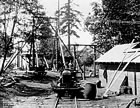 A
newspaper article in 1923 reported that the tram-rail system moved an
estimated 3,000 tons of Nelson Island granite, 2,500 tons of brick and
tile, 2,800 tons of sand and gravel, 500 tons of cement and 500 tons
of sundries.
A
newspaper article in 1923 reported that the tram-rail system moved an
estimated 3,000 tons of Nelson Island granite, 2,500 tons of brick and
tile, 2,800 tons of sand and gravel, 500 tons of cement and 500 tons
of sundries.
When the campus opened for classes in September 1925, not only did students find a campus much less grandiose than that envisaged in the original plans, they also came to a campus not quite completed. Gathering for the inaugural assembly students had to sit on the floor of the auditorium as the seats had not yet been installed. Outside landscaping had not been completed - there were no grassed lawns or trees, roads and walkways were still under construction, piles of building debris still littered the site and laboratory equipment and services in the Science Building were incomplete. None of this mattered, however, as the University, after much effort by many people, finally had its permanent home.
 Over
the next few years many of the large and small deficiencies would be
resolved. One of the most pressing concerns had been the lack of a gymnasium
at Point Grey. After UBC students learned that the government would
not construct a gymnasium, they undertook a series of fundraising projects
beginning in 1923 and raised nearly $8,000 within a year. The students
secured the remaining $30,000 by agreeing to increase their annual fees,
to pay down a bond guaranteed by the Alma Mater Society. Because this
process took time to organize, it was November 1929 before the Gymnasium
opened and was officially turned over to the University by the students.
This student contribution to the campus was only the beginning of a
precedent that would be followed several more times over the years.
Over
the next few years many of the large and small deficiencies would be
resolved. One of the most pressing concerns had been the lack of a gymnasium
at Point Grey. After UBC students learned that the government would
not construct a gymnasium, they undertook a series of fundraising projects
beginning in 1923 and raised nearly $8,000 within a year. The students
secured the remaining $30,000 by agreeing to increase their annual fees,
to pay down a bond guaranteed by the Alma Mater Society. Because this
process took time to organize, it was November 1929 before the Gymnasium
opened and was officially turned over to the University by the students.
This student contribution to the campus was only the beginning of a
precedent that would be followed several more times over the years.
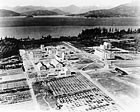 As
the 1920s drew to a close, the prospects for the U.B.C. seemed bright.
The University had finally moved to its Point Grey home which now provided
space for its 1,500 students with plenty of space for future expansion.
The institution also seemed to enjoy the general support of British
Columbians. Unfortunately, despite the long struggles that brought the
institution to its new home, it was not to be allowed the luxury of
enjoying such favourable circumstances for very long. Even as the looming
clouds of the worldwide Depression gathered, the University would also
have to ready itself for new threats to its independence and autonomy
from the provincial government. These challenges will, however, have
to be a story for another day.
As
the 1920s drew to a close, the prospects for the U.B.C. seemed bright.
The University had finally moved to its Point Grey home which now provided
space for its 1,500 students with plenty of space for future expansion.
The institution also seemed to enjoy the general support of British
Columbians. Unfortunately, despite the long struggles that brought the
institution to its new home, it was not to be allowed the luxury of
enjoying such favourable circumstances for very long. Even as the looming
clouds of the worldwide Depression gathered, the University would also
have to ready itself for new threats to its independence and autonomy
from the provincial government. These challenges will, however, have
to be a story for another day.